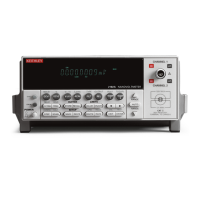• Buffer operations — Explains how to store and recall readings including buffer
statistics (minimum, maximum, peak-to-peak, average, and standard deviation).
• SCPI programming — Covers the SCPI commands used to control buffer operations.
Buffer operations
The Model 2182 has a buffer to store from two to 1024 readings and units. It also stores the
channel number for step/scan readings and overflow readings. In addition, recalled data includes
statistical information (minimum, maximum, peak-to-peak, average, and standard deviation).
NOTE Statistics are not calculated when an overflow reading has been stored in the buffer.
The buffer fills with the specified number of readings and stops. Readings are placed in the
buffer after any math operations are performed. Math operations include Relative, Ratio or
Delta, and mX+b or Percent.
Buffered data is overwritten each time the storage operation is selected. The data is volatile;
it is not saved through a power cycle.
NOTE Measurements performed during stepping or scanning are automatically stored in the
buffer. There is no need to configure and enable the buffer. Stepping and scanning is
covered in Section 9.
NOTE When changing the interface (GPIB to RS-232, or vice versa), all data in the buffer clears.
Store
Perform the following steps to store readings:
1. Set up the instrument for the desired configuration.
2. Press the STORE key.
3. Use the cursor keys ( and ), and the RANGE and keys to set the number of
readings to store (2 to 1024).
4. Press ENTER to enable the buffer. If in the immediate trigger mode, the storage process
will start immediately. If in the external trigger mode, each input trigger (or press of
TRIG key) will store a reading.
NOTE The asterisk (*) annunciator turns on to indicate that the data storage operation is
enabled. It will turn off when the storage process is finished (buffer full).
6-2 Buffer

